Tight muscles in your low back can be hard to address, and even harder to live with! Staying active, strengthening your core and glutes, and stretching certain muscle groups can help. Here are 8 Lower back stretches to help you move better (and 2 bonus stretches to keep your back healthy!)
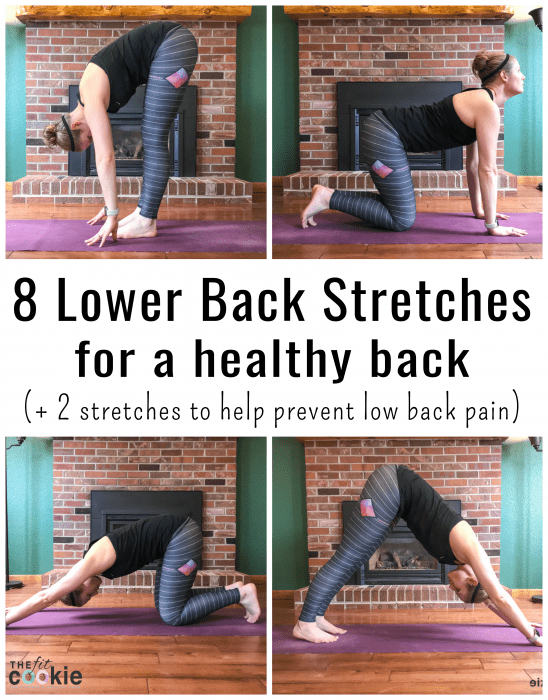
Did you know that lower back pain is the single leading cause of disability globally? Low back pain is, for lack of a better term, a true pain in the neck (or butt, leg,…). Over 80% of Americans will experience low back pain at some point in their lives, so it’s a problem that many people can relate to (source).
I really haven’t had chronic lower back pain, but I have had lower back pain off and on for various reasons over the years: getting bucked off a horse, an ovarian cyst, menstrual cramps, sore muscles from exercise, post-surgery aches, and more.

But typically with care, stretching, heat, and some occasional chiropractic adjustments, things usually get back to normal for me after not too long. But stretching and myofascial release has become a staple for me, otherwise I get tight and achy for sure.
If you struggle with low back pain, whether it’s from muscle imbalances or old injuries, there are stretches that can help with the pain. As with any stretching or exercise routine, always talk to your doctor first to see if these stretches are appropriate for you and your body.
Steps for addressing lower back pain
Addressing muscle imbalances can play a big role in helping to reduce lower back pain and improve activities of daily living. Obviously there are certain low back injuries (like disc herniation) and disorders (like spinal stenosis) that can’t be fixed just by stretching, but stretching can help improve some pain even in those cases.
** If you have a spinal injury or disorder, always speak to your doctor or medical professional before doing a new stretching or exercise program! **
- Strengthen your entire core (this includes not only your rectus abdominis in the front, but your oblique muscles in your sides and your back extensors muscles)
- Address tight hip flexors (this is especially a problem if you sit a lot)
- Address tight hamstrings (also a problem if you sit a lot)
- Address tight piriformis muscles
- Strengthen (and stretch!) gluteus muscles
You probably already know this but it bears repeating: if your lower back pain persists, get it checked out! It could signal deeper injuries, spinal malformations, ovarian cysts or cancers, nerve problems, or more. Don’t ignore your body’s pain signals that something could be wrong.
Lower back stretches for a healthy back
Part of the steps for addressing lower back pain is addressing muscle imbalances
Some of these stretches might look a little different than you’re used to seeing them. For example, in child’s pose, my back has more rounding in it since I have hip impingement and I am limited in my hip mobility.
I share this for 2 reasons: 1) in case people feel the need to judge my form on certain poses, and 2) to also demonstrate that even if you have physical limitations, you can still stay physically active within your abilities! Do what you can do and don’t compare yourself to others 🙂
I’ve set up these lower back stretches so that you can do them in sequence from standing stretches to floor stretches. You can skip any of these poses that feel awkward or uncomfortable – do what you can do and don’t force yourself into the stretches or poses to avoid injury.
Click here for the printable and downloadable PDF
One important thing to note: don’t over-stretch!
Especially if you are not used to stretching a lot or you have back problems, only stretch to comfort. Flexibility will come with time and consistency, don’t force yourself into stretches, that’s when pulled muscles and injuries can happen.
As you become more flexible, then you can challenge yourself a bit to stretch further, but don’t do too much too soon.
If you have injured muscles or pulled muscles already, it is especially important not to over-stretch them or they won’t heal. Speaking from personal experience, over-stretching a pulled muscle means it will take longer to heal. Gently stretch to comfort and stop if there is pain.
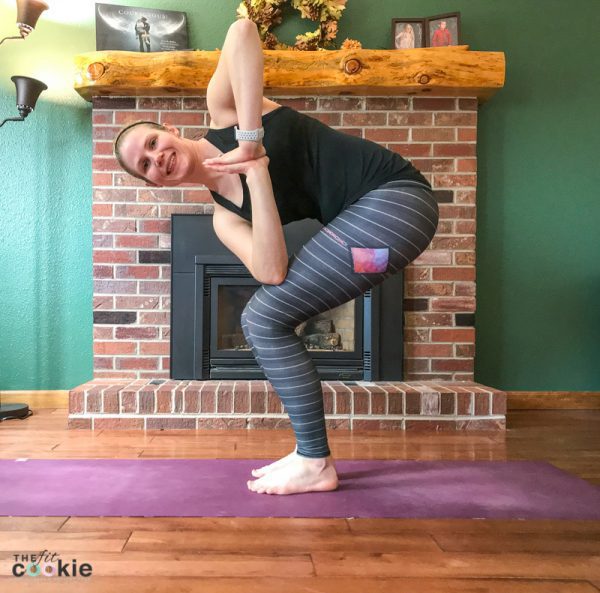
Revolved chair: from a standing position, lower your hips down and back into chair pose, then add a spinal twist by pressing your hands together in prayer position and bringing one elbow to the outside of the opposite leg. Hold this pose for several breaths, lifting and opening your chest. Release back to standing and then repeat on the other side.
Things to consider (contraindications): if you have a spinal injury where you should avoid twists, avoid the revolved chair pose.
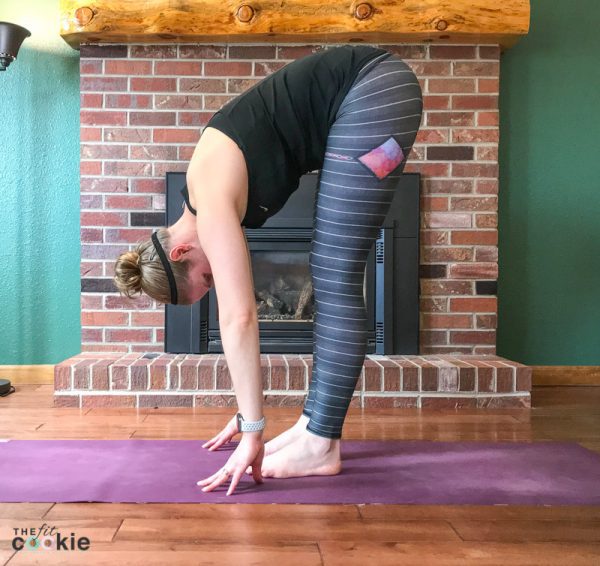
Forward fold: from a standing position, gently hinge forward through your hips and reach down toward the floor (or wherever you are comfortable reaching, see below). Make sure that you are not bending through your back by rounding your back, but rather hinging through your hips. This will protect your back and give you the best stretch in your low back and hamstrings.
Things to consider (contraindications): for certain back injuries (like disc herniations or bulging discs) you may need to avoid folding stretches like these.
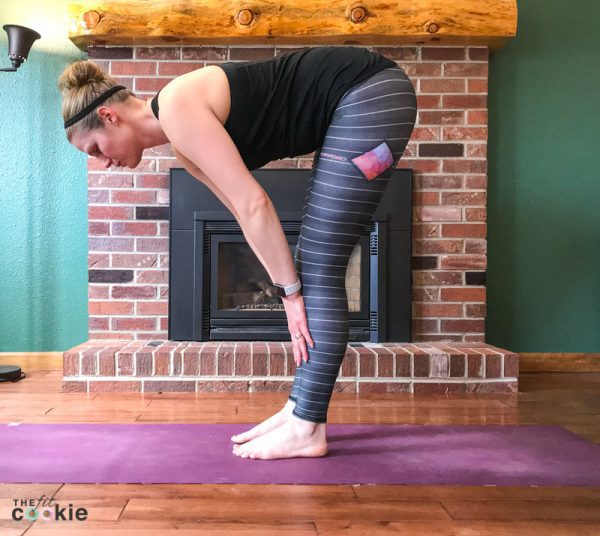
Above is a photo of a modified forward fold if you can’t reach the floor. You can also reach to a yoga block or a chair instead of reaching to your shins or knees. Either way, make sure that you hinge forward through your hips in this stretch and avoid rounding your back.
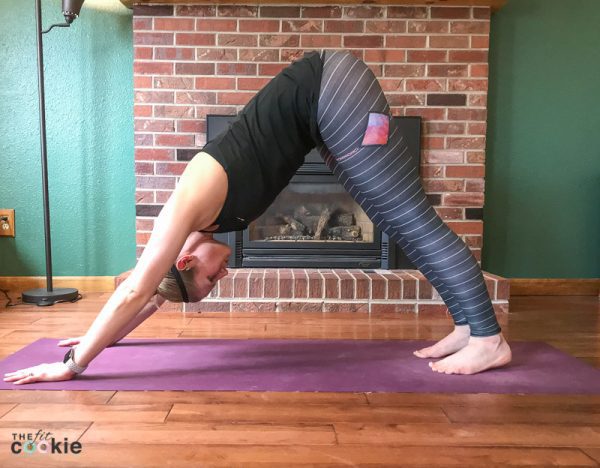
Down Dog: from a plank position, press your hips up to the sky, making only small adjustments to hand and feet positions. Down dog should be performed right from plank, so there should be no need to adjust your hand and feet positions unless you must.
Extend your shoulders and draw your shoulder blades down your spine toward your hips. Lift your tailbone to the sky, and press your heels toward the floor (they don’t have to touch the floor). Make sure not to hyperextend or lock your shoulders and knees.
Things to consider (contraindications): If you have shoulder injuries, you may need to avoid down dog pose. If you have wrist problems, try dolphin pose using elbows instead of hands in this position.
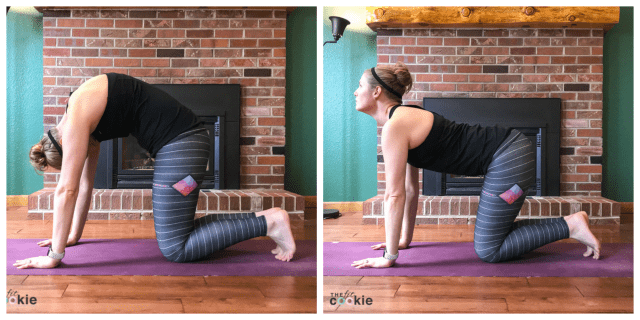
Cat + cow pose: cat and cow pose when performed together make a great full back stretch and an awesome full back warm-up if done before exercise. From all fours (hips stacked over knees and shoulders stacked over wrists), round your back up and hollow your stomach in cat pose.
Hold this for 1-2 breaths, then release and let your belly hang down allowing your back to release to the floor a bit, lifting your chin to comfort. Hold for 1-2 breaths and repeat. You can perform cat and cow together for several reps as a stretch and as a warm-up for your back.
Things to consider (contraindications): there is typically very little risk in this exercise since it’s easy to do correctly, just make sure that you listen to your body and avoid over-arching your back in either direction if it’s uncomfortable or your doctor wants you to avoid it. Add cushion under your knees or wrists if needed.
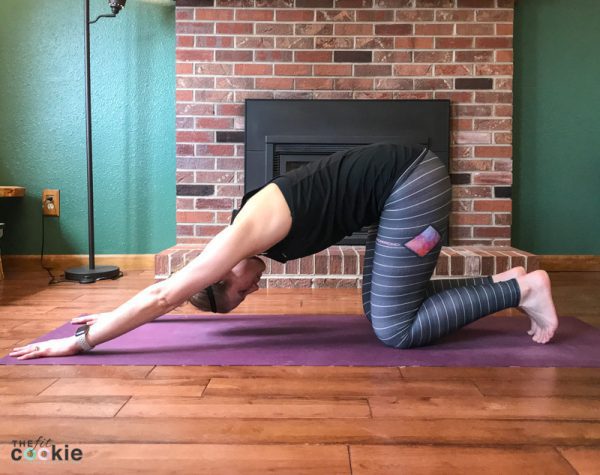
Puppy pose: puppy pose is like a cross between child’s pose and down dog (hence the name puppy pose). From an all fours position, walk your hands out to stretch your upper body, but keep your hips high and stacked above your knees. This lengthens your spine and also helps to stretch and open your chest.
Things to consider (contraindications): you can add extra cushion under your knees here if you have knee problems. A folded blanket or mat, or a pillow works. Puppy pose can be easier on your knees and hips than child’s pose, but can also pose problems if you have shoulder injuries. Listen to your body, and avoid sinking into your shoulder joints in this pose if you have shoulder injuries.
Below is a photo of puppy pose with an added shoulder stretch, perfect if you need to stretch your upper back! Avoid this stretch if you have back injuries where you should not twist.
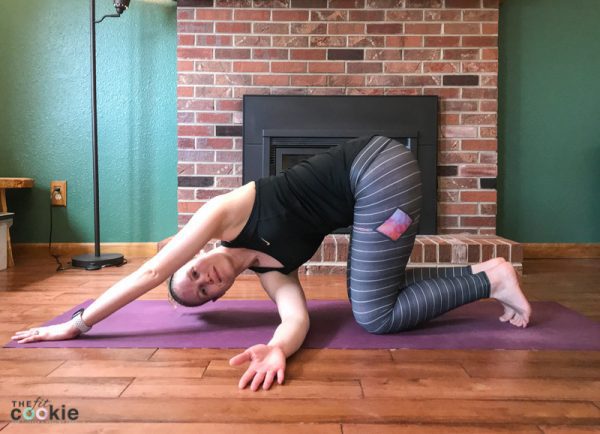
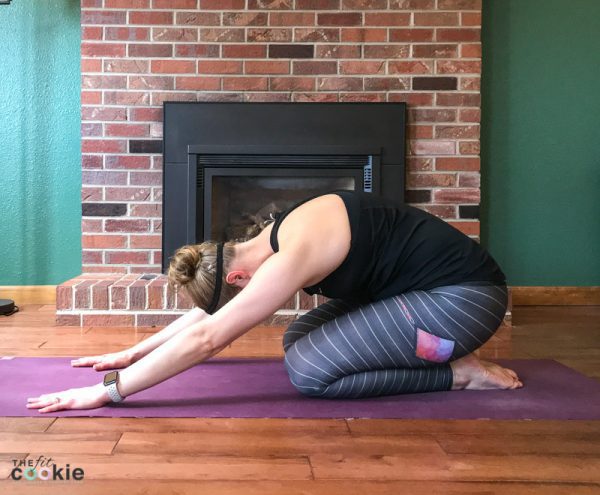
Child’s pose: on a mat (with extra cushion under your knees if you need it), begin in all fours on your hands and knees, then sit back on your feet, stretching your upper and lower back.
Things to consider (contraindications): If you have hip problems, you can bring your knees out wider to make your hips more comfortable, or add a yoga block or blanket under your hips for support. If you have knee problems, you can lift your hips a little bit, or put a rolled up blanket or mat under your knees to reduce the angle of bend at your knees.
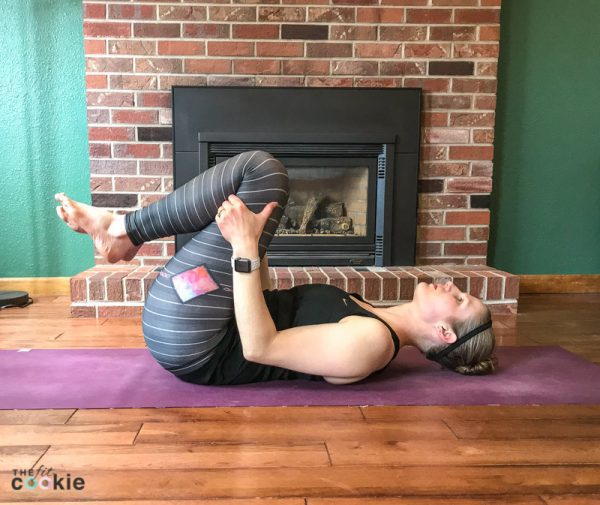
Knees to chest: lying on the floor or mat, bring your knees up toward your chest (it’s okay if your knees don’t go all the way to your chest). Hold this stretch for 30-60 seconds or as long as you are comfortable. I often will gently rock back and forth a little bit to massage my low back in this position. One of the simplest low back stretches you can do!
If you need to do this stretch at work or whenever its not practical to get on the floor, you can do a standing knee to chest stretch for your low back.
Things to consider (contraindications): if you have hip problems, don’t worry about bringing your knees closer to your chest than is comfortable. If you have knee problems, place your hands under your knees rather than on top of them so you aren’t pulling down on your knee joints.
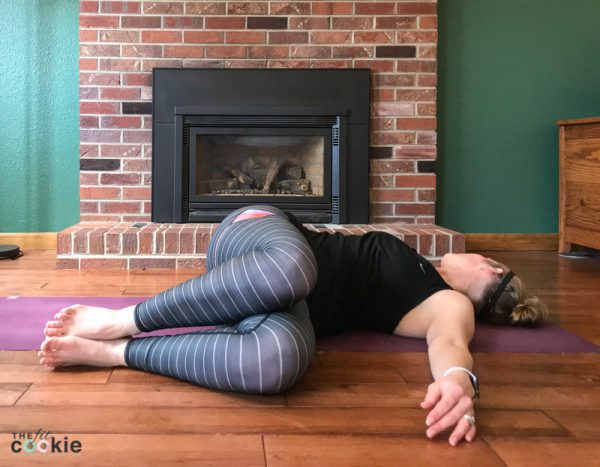
Reclining Twist: from knees to chest pose, release your knees away from your chest a bit so they are at a right angle to the floor, then gently release your knees to one side. Look the opposite direction for a full spinal twist. This also helps to open up the chest a bit if you allow your shoulders to rest on the floor (to comfort).
This is one of my favorite lower back stretches! I don’t have back problems, but if I feel like my back is tight, this is my go-to stretch.
Things to consider (contraindications): if you have spinal injuries and your doctor has told you not to do twists, avoid this stretch.
Other stretches to help prevent back pain
Part of the steps for addressing lower back pain is addressing muscle imbalances in the hip flexors, hamstrings, glutes, and core. Tight hip flexors can cause pelvic tilt that can put undue pressure on the low back, and tight hamstrings can limit the normal range of motion in your back.
Here are a few other stretches you can do daily to help relieve tight hip flexors, hamstrings, and piriformis muscles that can translate into low back pain for many people.
These stretches are especially important if you sit a lot! If you work extensively at a desk or in a vehicle, make sure you take time regularly throughout the day to do these stretches. Your back (and the rest of your body) will thank you 🙂
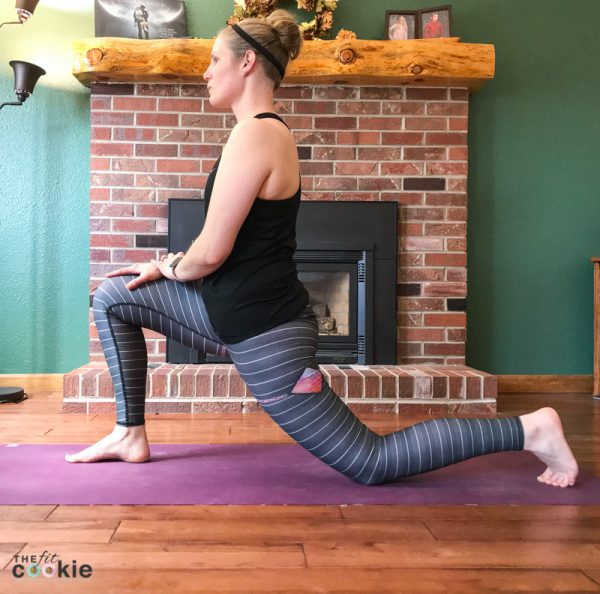
Kneeling Hip flexor stretch: stand on your knees on a mat (I highly recommend added cushion under your knees for this stretch!) and bring one leg in front so you’re kneeling on one knee. Gently press your hips forward until you feel a good stretch in the front of your hip and top of your thigh. Adjust your forward leg as needed to keep your knee from going past your toes too much.
Hold this stretch for 30-60 seconds, and repeat on the other side. You can do a few reps of these, and do them several times throughout the day. Make sure that you lift your chest, but do not arch your low back.
Things to consider (contraindications): Make sure you add extra cushion under your knee if you need it, and take care with this stretch if you have hip problems or hip impingement as this can sometimes cause a pinch point in the hip of the forward leg with FAI.
You can always use blocks under your hands for support in this stretch. You can also reduce the amount of stretch in this position if you have particularly tight hip flexors.
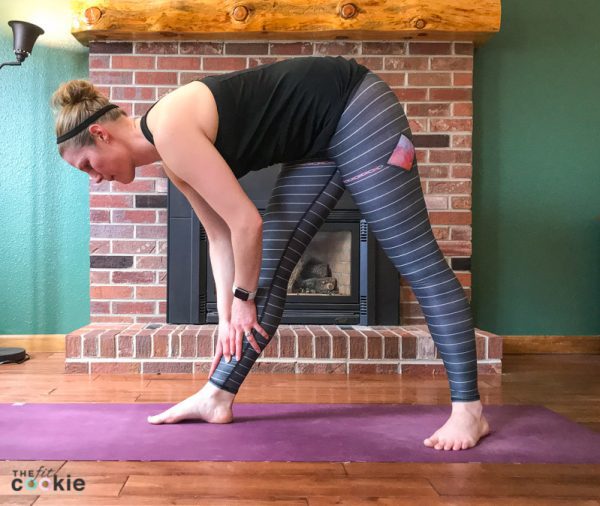
Pyramid (hamstrings): this pose provides an excellent hamstring and outer hip stretch that can be pretty intense if you have tight hamstrings. With one foot facing forward and the other at about 45 degrees, with both heels in line, keep your shoulders and hips square to the front of the mat.
Hinge through your hips keeping your back flat and reach down as far as you are comfortable down your forward leg trying not to round your back.
Things to consider (contraindications): If you have very tight hamstrings, you can modify this pose with blocks on each side of your feet, or you can modify by reaching just to your knee or shin. If your doctor has advised that you avoid forward folding/bending stretches, avoid this stretch.
Reclining pigeon: Another great pose to add for a piriformis and glute stretch is the reclining pigeon stretch (another one of my favorites, but for some reason I forgot to get photos of this one!). This is also a great stretch if you have sciatica. I use this stretch with my personal training clients who have sciatica to help relieve their recurring pain and it helps relieve pressure on the sciatic nerve.
Don’t forget to strengthen your glutes and core along with these stretches to help prevent future lower back pain and maintain a healthy back!

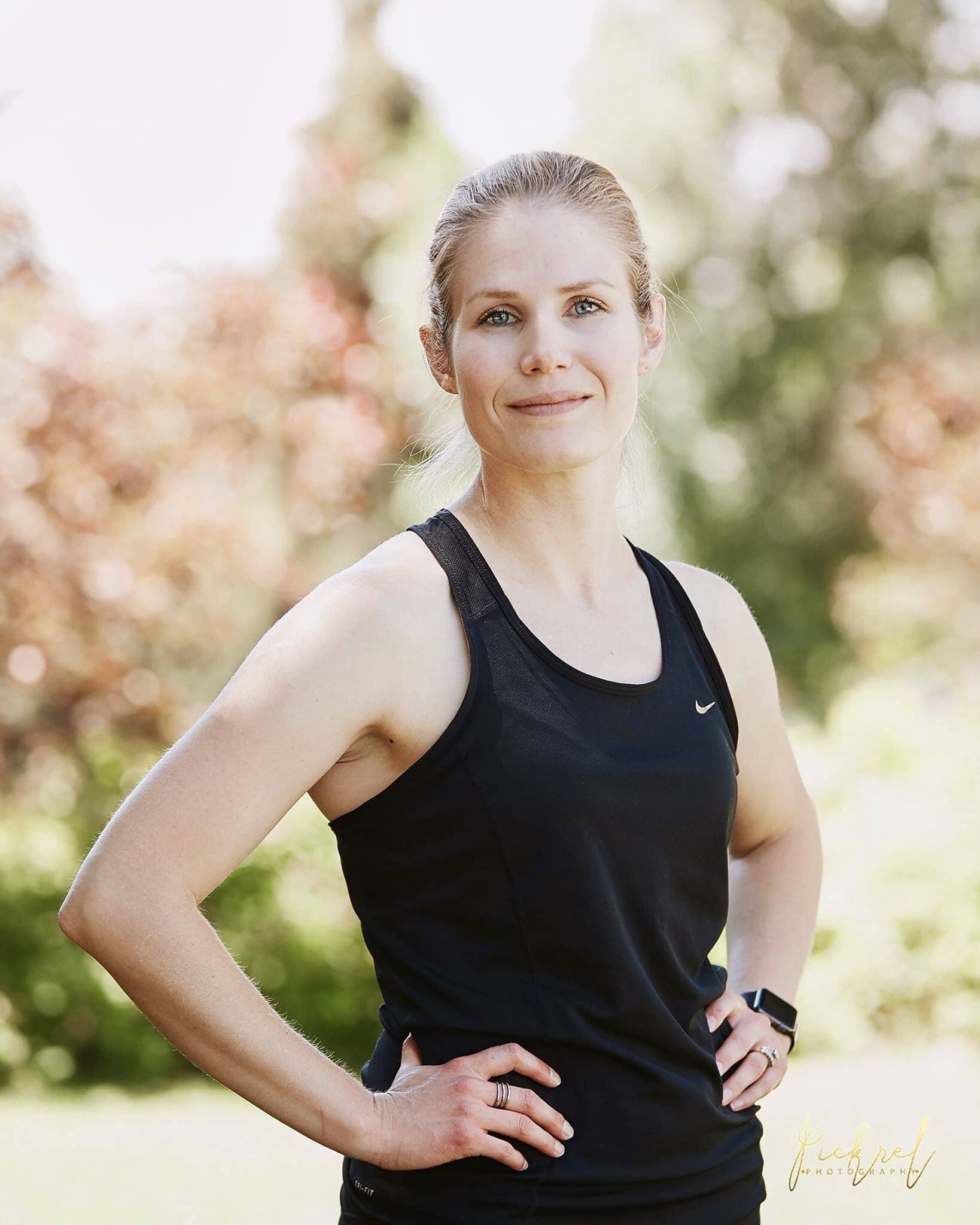
Sarah Jane Parker is the founder, recipe creator, and photographer behind The Fit Cookie. She’s a food allergy mom and healthy living blogger based in Wyoming. Sarah is also an ACSM Certified Personal Trainer, ACE Certified Health Coach, Revolution Running certified running coach, and an ACE Certified Fitness Nutrition Specialist

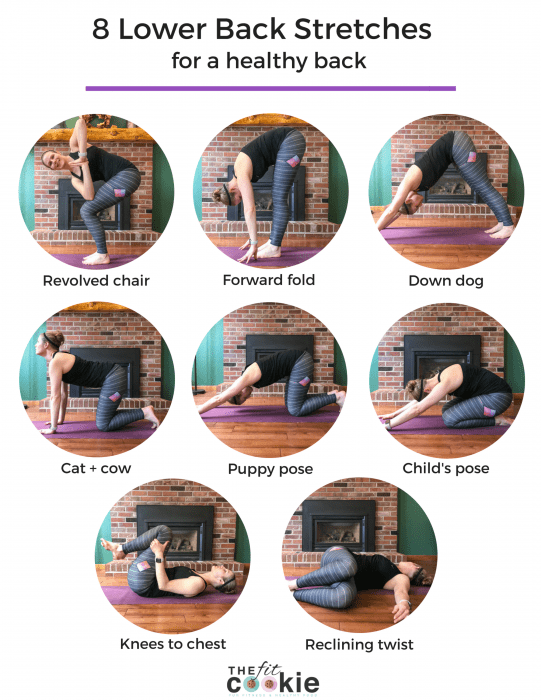
Hey Sarah Jane, great content. I am a physiotherapist in Calgary and I recommend a lot of these stretches to my patients suffering from lower back injuries. Another great stretch is the piriformis stretch. this stretch works your piriformis muscle, which is found deep in your buttocks. To do a piriformis stretch:
1. Lie on your back with both knees bent and your feet flat on the floor.
2. Place your right ankle at the base of your left thigh.
3.Then, place your hands behind your left thigh and pull up towards your chest until you feel a stretch.
3. Hold this position for 1 minutes
4. Switch sides!
That’s one of my favorites, thank you!
Love the reclining twist! Great way to release the lower back and is simple to perform.
It’s one of my favorites for sure!